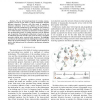86
Voted
WCNC
2008
IEEE
15 years 7 months ago
2008
IEEE
A computer simulation model is proposed for discretetime doubly-selective compound-K fading channel. It first generates multiple independent mobile-to-mobile Rayleigh fading Chan...
WCNC
2008
IEEE
15 years 7 months ago
2008
IEEE
Abstract—We examine the statistical distribution of the interference produced by a cluster of very many co-channel interferers, e.g., a sensor network, or a city full of active w...
110
click to vote
WCNC
2008
IEEE
15 years 7 months ago
2008
IEEE
—Iterative K-best sphere detection (SD) and channel decoding is appealing, since it is capable of achieving a nearmaximum-a-posteriori (MAP) performance at a low complexity. Howe...
WCNC
2008
IEEE
15 years 7 months ago
2008
IEEE
— In this paper, we address the network maintenance problem, in which we aim to maximize the lifetime of a sensor network by adding a set of relays to it. The network lifetime is...
WCNC
2008
IEEE
15 years 7 months ago
2008
IEEE
— In this paper we demonstrate that our ability to match the EXtrinsic Information Transfer (EXIT) function of an Irregular Variable Length Code (IrVLC) to that of a seriallyconc...
91
Voted
WCNC
2008
IEEE
15 years 7 months ago
2008
IEEE
— In an opportunistic spectrum sharing (OSS) wireless network there are two types of users: primary users and secondary users. The primary users own the license for the system ba...
100
Voted
SECON
2008
IEEE
15 years 7 months ago
2008
IEEE
—Traditional rate adaptation solutions for IEEE 802.11 wireless networks perform poorly in congested networks. Measurement studies show that congestion in a wireless network lead...
PIMRC
2008
IEEE
15 years 7 months ago
2008
IEEE
— The Internet of Things, emerging pervasive and sensor networks are low data-rate wireless networks with, a priori, no specific topology and no fixed infrastructure. Their pri...
80
Voted
PIMRC
2008
IEEE
15 years 7 months ago
2008
IEEE
Abstract—The use of licensed spectrum for wireless communication is driven by the need to control interference between different operators. However, with this mode of regulation,...
120
Voted
PERCOM
2008
ACM
15 years 7 months ago
2008
ACM
In this paper, we present a new concept of distributed adaptation and P2P streaming supporting the expansion of context-aware mobile P2P systems. Here, we propose to adapt video c...







